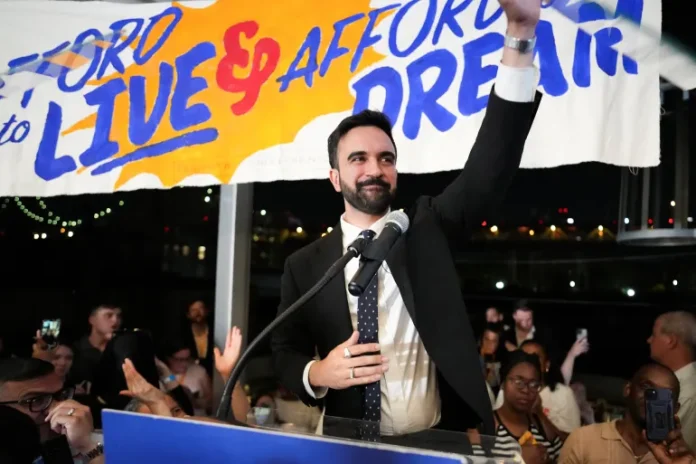– Atoofa Nasiha
After an awestruck win in the Democratic primary against heavyweight rivals, Zohran Mamdani has emerged as the frontrunner in New York City’s mayoral race. At just 33, the Queens Assemblyman has jolted the political establishment, carrying with him an agenda rooted in affordability, housing reform, and grassroots power. With prediction markets already giving him an 84 percent chance of victory, Mamdani’s candidacy is no longer seen as an outsider bid but as a serious test of how far progressive politics can reach in America’s largest city. His rise is not only about policies but also about how his message of economic fairness and dignity is resonating across boroughs.
Let’s see the hot take on Mamdani’s Mayoral race:
- Forecast: Approximately 84 Percent Chance of Victory
Within hours of his primary triumph, prediction markets and betting platforms such as Kalshi, PredictIt, and Polymarket projected Mamdani’s likelihood of winning the general election at around 84 percent, suggesting a clear path toward a commanding victory in November (Fox Business, Newsweek).
- Core Focus: Affordability, Housing, Transit, and Care
Mamdani’s platform centers on affordability for working New Yorkers. It includes a rent freeze for stabilized units, a $30 minimum wage by 2030, city-owned grocery stores, fare-free buses, universal childcare, fast-tracked affordable housing, and protections against deed theft (Campaign website, Wikipedia).
He positions these policies as practical and necessary, not ideological, aimed at easing everyday costs from housing to groceries to childcare for families across demography (The Guardian, Time).
- Detailed Housing Strategy
Mamdani’s housing plan is bold. It pledges to freeze rents in about 1 million rent-stabilized units and build 200,000 permanently affordable homes over ten years, funded via taxes on the ultra-rich and municipal bonds. He also plans to appoint allies to housing regulation boards back in line with tenant protections and state-level expansion of rent stabilization (Time, Wikipedia).
- Strategic Outreach to Older Black New Yorkers
Despite strong backing from younger progressives, Mamdani underperformed in Black-majority neighborhoods during the primary. Analysts say older Black voters prioritize proven experience. He is now intentionally focusing on this group by emphasizing shared affordability struggles and intergenerational fairness (AP News).
- Pushback, Accusations, and Composed Responses
Critics have attacked him from multiple angles by highlighting ties to DSA and labeling his agenda radical. Editorials raise concerns over proposals like decriminalizing sex work and allowing undocumented political participation. In response, Mamdani has maintained composure, insisting that practical solutions to cost-of-living challenges define his campaign and not ideology (New York Post, New York Post).
- Concerns from Small Landlords
Independent landlords managing rent-stabilized buildings have warned that rent freezes may undermine their financial stability, reduce reinvestment in properties, and hurt housing supply. Mamdani has acknowledged these concerns, offering hardship relief while stressing that the freeze is temporary and coupled with building expansion (New York Post).
- Fundraising Surge and Grassroots Strength
Financially, Mamdani leads the race with more than $4.4 million in the bank, including significant public matching funds. He has outpaced rivals like Cuomo and Adams, showcasing robust grassroots funding driven by everyday donors (The Guardian, New York Post).
- Endorsements, Influence, and Media Appeal
His campaign has attracted endorsements from progressives such as Alexandria Ocasio-Cortez, Bernie Sanders, and Elizabeth Warren, along with backing from major labor unions like SEIU 32BJ and UFT. Social media influencers and Gen-Z activists have heightened his visibility among younger voters (Vanity Fair, Wikipedia).
- Campaign Tone: “Living Rent-Free in His Head”
A standout moment came when Cuomo challenged Mamdani’s rent-stabilized apartment. Mamdani replied wryly:
“What Andrew Cuomo is proposing … reflects that I’m living rent-free not in my apartment but in his head.”
His ability to neutralize attacks with humor and focus helped defuse criticism and reinforce his messaging (ABC7NY).
- Polls and Voter Sentiment
Recent polling places Mamdani firmly in the lead with 41.8 percent, ahead of Cuomo (23.4 percent), Sliwa (16.5 percent) and Adams (8.8 percent). In every hypothetical drop-out scenario, he maintains a meaningful advantage. The undecided segment, primarily older voters, could still shape the outcome, making outreach essential (AARP-Gotham Polling & Analytics, CBS New York).
- New Yorker’s Expectations
Across boroughs, voters, especially younger and working-class, are rallying behind his affordability agenda. Many describe feeling priced out of their city. Seniors and long-time residents, initially skeptical, express growing hope as Mamdani emphasizes stability and action without gimmicks (AP News, AARP).
- Historical Context and Potential Shift
A 33-year-old Democratic Socialist ascending to this level of power in New York City marks a significant change in political norms. His grassroots model, youth engagement, and crowdfunding mirror a national trend reshaping urban politics. If successful, Mamdani may represent both continuity of progressive tradition and a new era of people-driven campaigns (The Guardian, Vox).
Mamdani’s path forward is not without resistance, but his ability to blend composure with bold proposals has kept his campaign steady. From housing debates to endorsements by nationally recognized leaders, he has shown both resilience and momentum. Polls place him firmly in the lead, yet the true measure of his candidacy lies in how he connects with voters who feel excluded from the city’s growth. For many New Yorkers, his campaign embodies the hope that leadership can still be about people rather than power. If the numbers hold, Mamdani may soon turn his vision of affordability and equity into a governing reality, signaling a profound shift in how the city defines its future.




